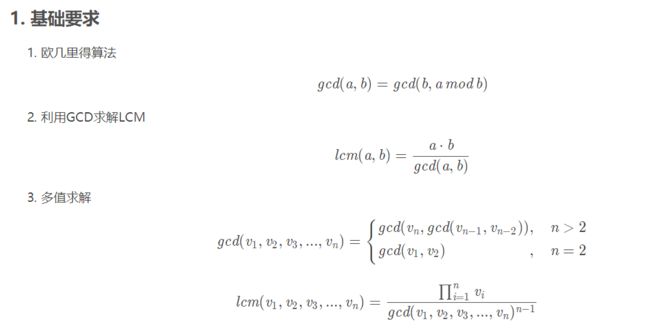http://codeforces.com/problemset/problem/992/B
题意:
给你区间[l,r]和x,y 问你区间中有多少个数对 (a,b) 使得 gcd(a,b)=x lcm(a,b)=y ,如果a,b交换位置就是不同的数对
思路:
根据lcm(最小公倍数) 的定义 y=a*b/x; 也就是说 x∗y=a∗b ;
那么 ,我们发现a,b一定为y的因数,所以我们枚举y的每个因子就可以,我们只要用log(y)的复杂度暴力算每一个因数就可以 ,
然后对于每个因子当做a, b=x*y/a; 然后判断a,b是否在区间内,gcd(a,b)是否为x,(注意要判断是否等于b)
1 #include2 #include <string.h> 3 #include 4 #include <string> 5 #include 6 #include 7 #include 8 #include 9 #include 10 #include <set> 11 #include
Hankson的趣味题
Description
Hanks 博士是BT (Bio-Tech,生物技术) 领域的知名专家,他的儿子名叫Hankson。现 在,刚刚放学回家的Hankson 正在思考一个有趣的问题。 今天在课堂上,老师讲解了如何求两个正整数c1 和c2 的最大公约数和最小公倍数。现 在Hankson 认为自己已经熟练地掌握了这些知识,他开始思考一个“求公约数”和“求公 倍数”之类问题的“逆问题”,这个问题是这样的:已知正整数a0,a1,b0,b1,设某未知正整 数x 满足: 1. x 和a0 的最大公约数是a1; 2. x 和b0 的最小公倍数是b1。 Hankson 的“逆问题”就是求出满足条件的正整数x。但稍加思索之后,他发现这样的 x 并不唯一,甚至可能不存在。因此他转而开始考虑如何求解满足条件的x 的个数。请你帮 助他编程求解这个问题。
Input
输入第一行为一个正整数n,表示有n 组输入数据。
接下来的n 行每 行一组输入数据,为四个正整数a0,a1,b0,b1,每两个整数之间用一个空格隔开。输入 数据保证a0 能被a1 整除,b1 能被b0 整除。
接下来的n 行每 行一组输入数据,为四个正整数a0,a1,b0,b1,每两个整数之间用一个空格隔开。输入 数据保证a0 能被a1 整除,b1 能被b0 整除。
Output
输出共n 行。每组输入数据的输出结果占一行,为一个整数。
对于每组数据:若不存在这样的 x,请输出0; 若存在这样的 x,请输出满足条件的x 的个数;
对于每组数据:若不存在这样的 x,请输出0; 若存在这样的 x,请输出满足条件的x 的个数;
Sample Input
2 41 1 96 288 95 1 37 1776
Sample Output
6 2
HINT
样例说明
第一组输入数据,x 可以是9、18、36、72、144、288,共有6 个。
第二组输入数据,x 可以是48、1776,共有2 个。
数据规模和约定
对于 50%的数据,保证有1≤a0,a1,b0,b1≤10000 且n≤100。
对于 100%的数据,保证有1≤a0,a1,b0,b1≤2,000,000,000 且n≤2000。
题解:
https://www.cnblogs.com/five20/p/8434085.html
代码如下(无优化):
1 #include2 #include <string.h> 3 #include 4 #include <string> 5 #include 6 #include 7 #include 8 #include 9 #include 10 #include <set> 11 #include



